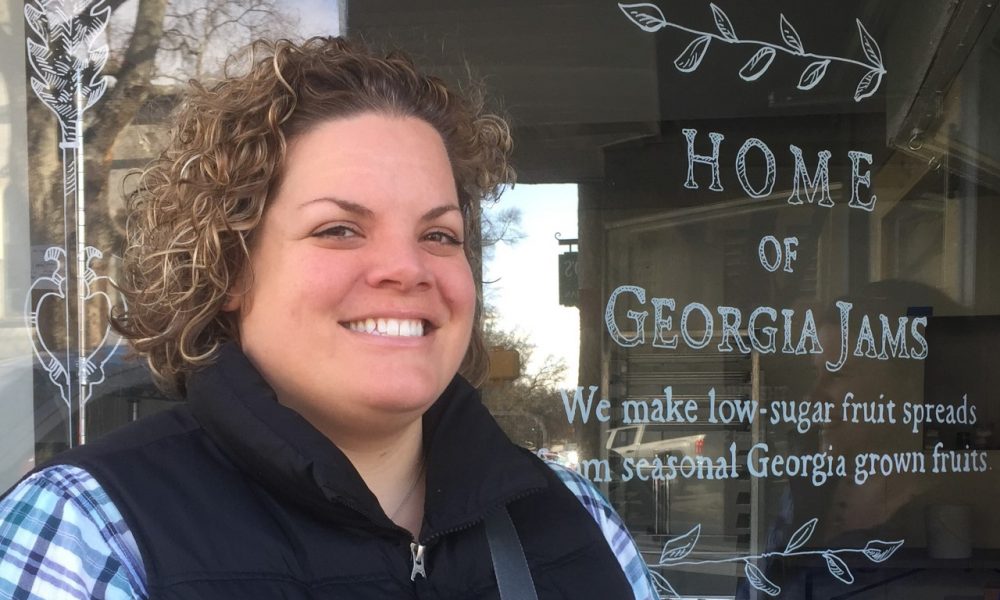

Today we’d like to introduce you to Lori Bean.
Lori, let’s start with your story. We’d love to hear how you got started and how the journey has been so far.
From the onset, I knew I wanted to make Georgia Jams from the fruit that we grow here in Georgia. I remember my Great-Grandmother, Sweetheart, in her small, hot summer kitchen, making pear preserves, muscadine, and fig, all from the fruit that grew in her yard. The tradition of preserving hadn’t carried on in my family, save a few batches of this or that my dad made on occasion. And when I made my first batch – although it wasn’t good, I was hooked.
I started making jams around 2008, after graduating from pastry school in Florida. The job market was terrible then, and there wasn’t much work for a new pastry chef. I moved back to Georgia and sold baked goods at the local farmer’s market and senior services center, and in August of 2009 I made my first batch of jam. It all started with a bag of muscadines, the Ball Blue Book, and Sweetheart’s canning tools. Let me tell you, the first few batches were not a success. Although I didn’t learn preserving in pastry school, the kitchen skills I gained helped with jam production. As I started to turn out successful batches and try my hand at new fruits, I brought those jams to the markets to offer alongside the baked goods, and they sold! Before long, I set aside the baking to focus on jams.
I established Georgia Jams in 2012, working the farmer’s market and festival circuit with my mom at my side for the schlepping and selling. Following the harvest seasons, we went to local farms to hand-pick fruit at the peak of ripeness. Using Georgia’s sweet, ripe fruits, I developed recipes using far less sugar than what you find in traditional jams and jellies. I was able to produce jams to sell to the public under a Department of Agriculture Cottage Exemption, a law that allowed baked goods and jams to be made from the home and sold to the public without licensing.
I moved Georgia Jams into a certified commercial kitchen in Griffin and was then able to increase production and offer my jams to retailers like Alon’s in ATL. With each new investment into labor, equipment, or technology, we’ve been able to grow Georgia Jams to meet demand. During the Covid-19 shut-down, we focused on redesigning our website and moving our commerce, both wholesale and retail, online.
Has it been a smooth road?
Entrepreneurship is not a smooth road by design. I don’t know too many success stories that aren’t full of mistakes and learning opportunities along the way. As owner/operator of Georgia Jams, I wore many hats, and in the beginning, I struggled to do most everything myself to keep labor costs down. That is a common mistake. As my dad used to say, “You can always make more money, you can’t make more time.” I have to say, I’ve been very fortunate to have the support of my family along the way, and as my company grew, my talented friends, who all own run creative businesses in Atlanta, offered their skills to make the product labeling on the outside of the jar match the quality on the inside. I had valuable input from Kent Schneider of Verde Home when it came time to give Georgia Jams a facelift. Leighanne Schneider creates the beautiful illustrations on my Georgia Jams labels, a different illustration for every fruit spread I make. Lawrence Wolfberg and Paul Bowman of MARKAtlanta.com have worked hard to elevate my branding by further refining the design and layouts. My friend Brook has recently joined the Georgia Jams team as a partner, working hard on the numbers and website side of the business. Turns out I not only can’t but don’t want to wear all the hats.
We’d love to hear more about your business.
At Georgia Jams, we make low-sugar fruit spreads with the best of the season’s harvest. The Georgia Jams name is a direct reflection, yet contradiction to what is in the jar. As it turns out, what I am producing, by definition, are fruit spreads. Because Georgia Jams are low-sugar, they cannot be classified as jam, jelly, or preserves by the Department of Agriculture’s brix (sugar content) guidelines. When I say low-sugar fruit spreads, I mean the very best Blueberries and Wild Honey Spread, Vidalia Onion Spread, or Peach State Spread you’ll ever have. My goal is to keep the fruit’s fresh flavor, and by using a lot less sugar we are able to highlight the natural sweetness of the fruit.
Over the years, Georgia Jams has established relationships with the farmers who grow the fruit we need, and scaling up means we need to buy, process, and freeze more fruit so we can make more jam. From the beginning, we set out to buy our fruits directly from Georgia farmers, and we’ve stuck to that. Our quality is unmatched, quite honestly, and that’s because we use the best fruit we can get our hands on. I’m proud that we’ve not only maintained our mission of supporting Georgia farmers over the years, but we’ve also put out an increasingly excellent product our customers have come to expect.
Is our city a good place to do what you do?
Operating Georgia Jams South of Atlanta, OTP, has been ideal for me. We’re centrally located to most farms, which is integral to our business model, but we’re also saving money by running a manufacturing facility outside of the perimeter. Starting at farmer’s markets introduced me to a lot of hard-working people who also run small businesses. Wherever you set up your business, look to establish relationships within your community. Those relationships will be valuable resources as you grow.
Pricing:
- 1.25 oz Georgia Jams are $3.50 per jar
- 9 oz Georgia Jams are $8.50 per jar
- 1.25 oz Jam Flights are $16 per jar
Contact Info:
- Website: www.GeorgiaJams.com
- Email: Lori@GeorgiaJams.com
- Instagram: Instagram.com/GeorgiaJams
- Facebook: Facebook.com/GeorgiaJams
- Twitter: Twitter.com/GeorgiaJams






 Image Credit:
Image Credit:
Brook Herren, Lori Bean
Suggest a story: VoyageATL is built on recommendations from the community; it’s how we uncover hidden gems, so if you or someone you know deserves recognition please let us know here.




















